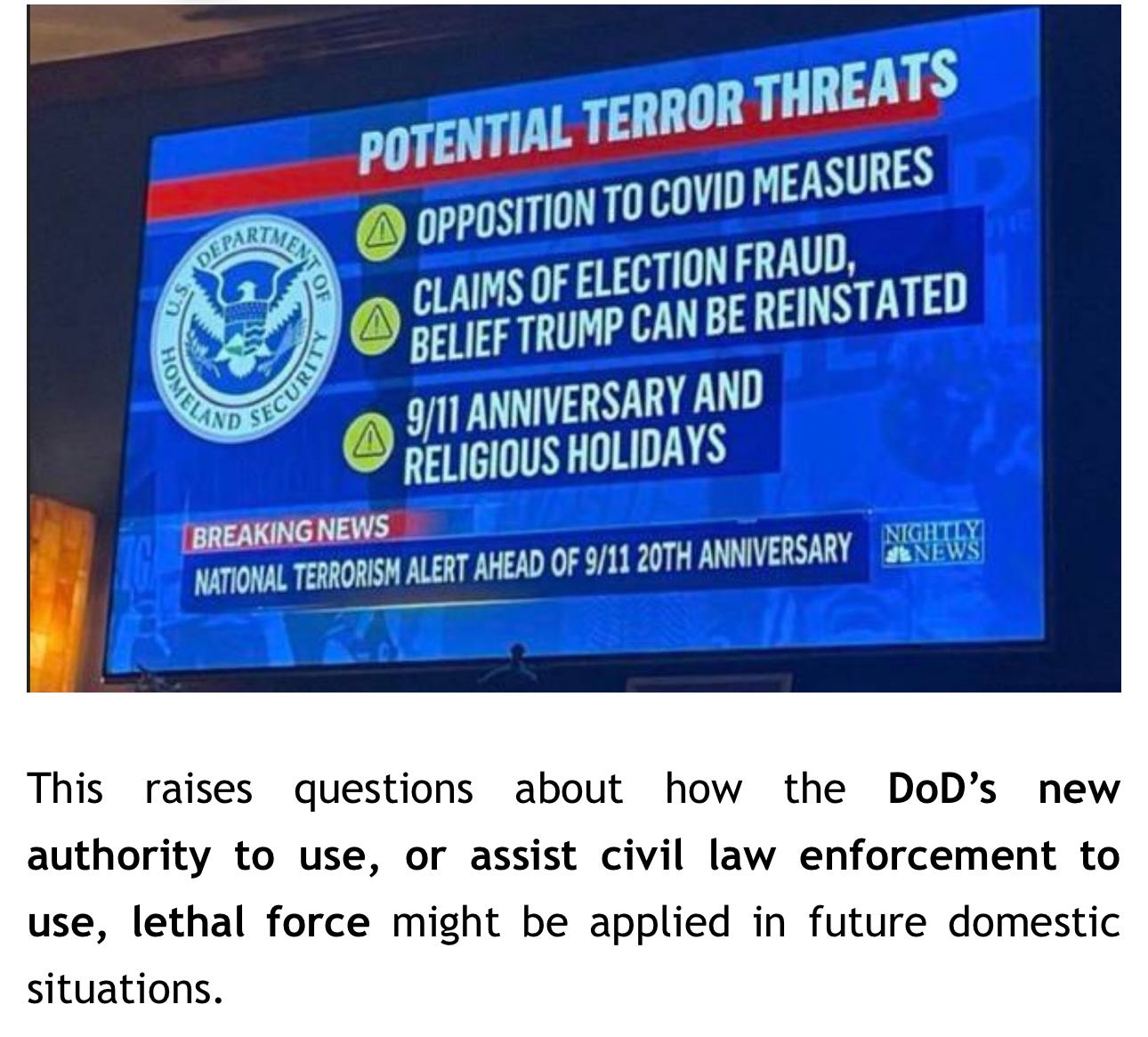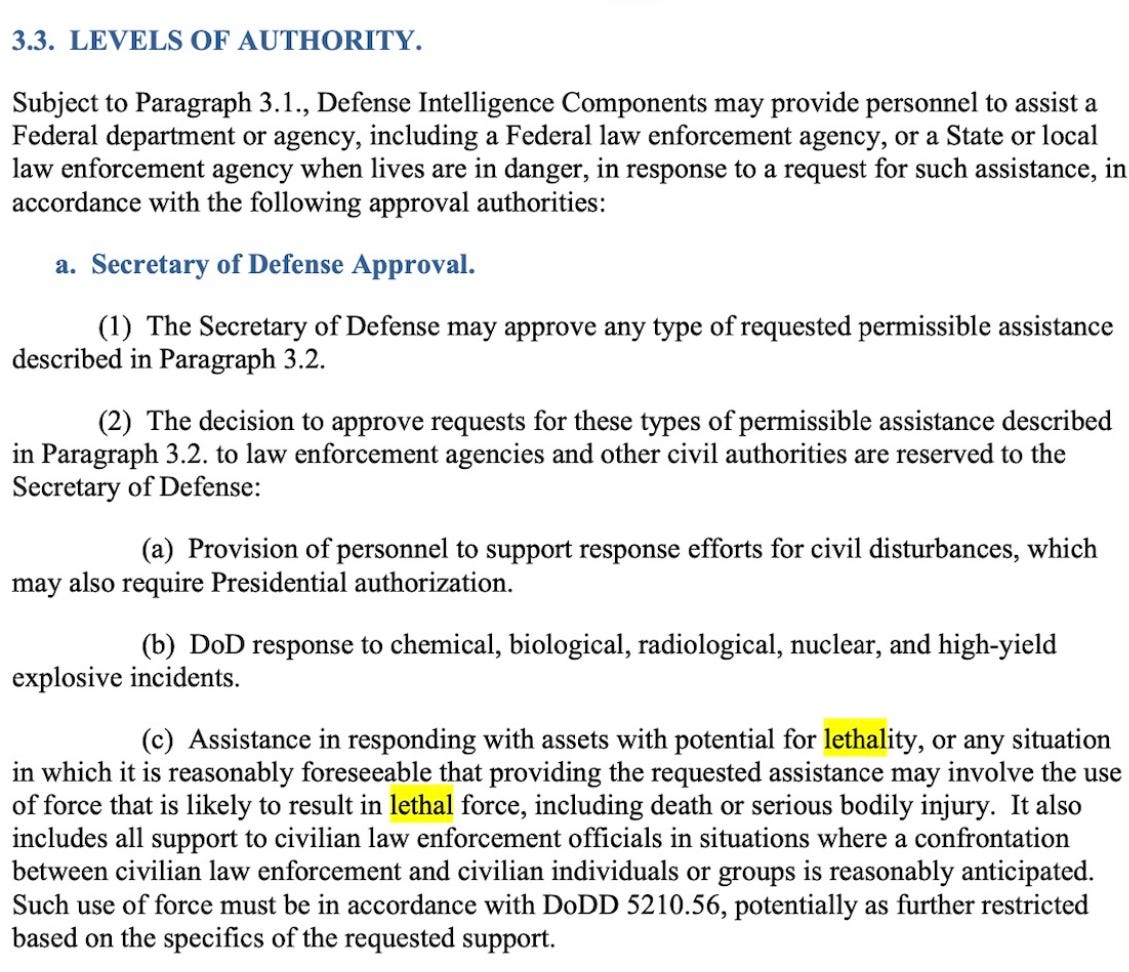The DoD Quietly Reissues Directive Expanding the Use of Lethal Force Against U.S. Citizens
October 14, 2024
With debates surrounding election integrity, civil unrest, and political manipulation, the expanded powers granted by the directive could lead to military intervention in domestic affairs if civil unrest arises.

Imagine waking up to discover that the U.S. military has quietly been granted the authority to assist in domestic law enforcement activities—including the use of lethal force against U.S. citizens in certain circumstances. Now consider that this change was enacted just weeks before an election, already surrounded by concerns about unrest, civil liberties, and potential government overreach. This is the reality of DoD Directive 5240.01, reissued on September 27, 2024.
-
New provisions: The updated directive expands the circumstances under which the DoD can assist law enforcement, including the use of lethal force.
-
Assassination explicitly forbidden: While assassination is banned, the new language allows for lethal actions under “imminent threats.”
-
Concerns about civil liberties: The expanded definition of “national security threats” is raising alarms, particularly given DHS’s broader definition of domestic terrorism threats.
-
High-level approval required: Any intelligence-sharing that could lead to lethal force must be approved by the Secretary of Defense, but Component Heads can act immediately for up to 72 hours before obtaining approval.
As the U.S. prepares for one of the most controversial and closely watched elections in its history, a concerning update to DoD Directive 5240.01 has quietly been put into effect. Reissued on September 27, 2024, this directive governs the Department of Defense’s (DoD) intelligence activities and now includes provisions authorizing lethal force in certain circumstances when assisting civilian law enforcement. While the directive forbids assassination, it opens the door to lethal interventions under “national security” conditions, albeit with stringent restrictions on how such interventions are to be authorized.
This directive, reissued under the authority of the Secretary of Defense as per standard Department of Defense procedures, carries significant weight in shaping military operations and intelligence activities. While DoD Directives are typically internal policy documents, the implications of this particular update extend far beyond the walls of the Pentagon, potentially affecting civilian life and constitutional rights.
A Quiet Update With Loud Implications
The reissuance of DoD Directive 5240.01 repealed previous versions, including the 1982 DoD 5240.1-R. While the update might seem routine, the changes regarding the use of lethal force in domestic operations are significant.
In the 2016 version, the directive primarily focused on intelligence collection and ensuring civil liberties protections for U.S. persons. It emphasized strict oversight and the need for authorization before collecting U.S. person information.
However, the 2024 version expands the military’s role, particularly in assisting civil law enforcement, and authorizes lethal force under specific conditions, raising questions about its use during potential civil unrest surrounding the election.
Read the DoD Directive 5240.01 here.
The Differences Between the 2016 and 2024 Versions
1. Focus of the 2016 Version
The 2016 version of the directive did not mention the use of lethal force. Instead, it focused on:
-
Civil liberties protections: Ensuring strict oversight for operations involving U.S. citizens.
-
Intelligence collection restrictions: Limiting when and how U.S. person’s information (USPI) could be collected.
-
Privacy safeguards: Protecting privacy rights and preventing unauthorized data collection.
The 2016 directive centered around intelligence gathering, with no mention of lethal force.
2. New Provisions in the 2024 Version
The 2024 update introduces a dramatic shift, particularly regarding domestic operations. Section 3.3.a.(2)(c) now explicitly permits lethal force in cases of imminent threats or national security emergencies, provided the action complies with legal oversight, specifically DoDD 5210.56, which governs the use of deadly force by DoD personnel.
Key updates include:
-
Use of lethal force: The directive allows military intelligence components to assist law enforcement in operations that involve lethal force.
-
Conditions for force: The directive specifies lethal force can be used under conditions involving imminent threats.
-
Legal oversight: Any use of lethal force must comply with DoDD 5210.56, ensuring proper legal frameworks are followed.
Framing the 2024 Directive as a Restriction, Not an Expansion
Although the directive expands the DoD’s powers, some interpret it as more restrictive than it appears. Section 3.3 places tight limitations on when intelligence-sharing can occur and requires approval from the Secretary of Defense before any action involving lethal force is taken. The requirement for high-level approval may serve as a check on potential misuse of military force.
The 72-Hour Provision: A Time-Sensitive Response Mechanism
Paragraph 3.5 introduces a 72-hour provision, allowing Component Heads to provide immediate intelligence assistance in time-sensitive circumstances without prior approval from the Under Secretary of Defense for Intelligence and Security (USD I&S) or the Secretary of Defense (SECDEF).
Key points:
-
Immediate action: Component Heads can act in situations where time constraints prevent obtaining prior approval.
-
Relevance to lethal force: This applies in scenarios where lethal force might be necessary to prevent imminent harm.
-
72-hour limit: The authority is valid for up to 72 hours, after which formal approval is required.
-
Immediate reporting: Component Heads must report their actions to the USD I&S and SECDEF.
-
Approval required for continuation: Any further assistance must be formally approved beyond the initial 72 hours.
Why Timing Matters: Implications for the 2024 Elections
The timing of this update—just six weeks before the election—raises concerns. With debates surrounding election integrity, civil unrest, and political manipulation, the expanded powers granted by the directive could lead to military intervention in domestic affairs if civil unrest arises.
Adding to the concern is the Department of Homeland Security’s recent expansion of what constitutes domestic terrorism. The DHS has flagged individuals questioning COVID-19 origins, vaccine efficacy, or election integrity as potential threats.

[Read our previous report on this topic here: The ‘Vaccine Hesitant’ & ‘Conspiracy Theorists’ a Domestic Terrorism Threat – New Homeland Security Report Implies].
Are you ready?
- Blue Monster Prep







